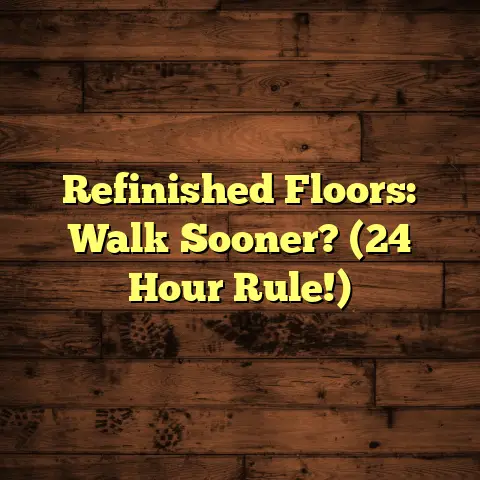Robot Vac For Pet Hair? (1 Vacuum NOW!)
I’m a flooring contractor, and let me tell you, I’ve seen it all when it comes to pet hair.
From tumbleweeds of fur blowing across hardwood floors to embedded messes in carpets, it’s a never- ending battle.
But guess what? We’ve come a long way from dustpans and brooms. I’m talking about robotic vacuum cleaners – those little helpers that promise to keep your floors fur-free with minimal effort.
Ever wonder where it all began? Let’s take a quick trip down memory lane, shall we?
Believe it or not, cleaning tools have been around for ages. Think back to ancient civilizations – the humble broom was a staple. Fast forward to the late 19th century, and boom! The first vacuum cleaner emerged, revolutionizing how we tackled dirt and dust.
And now? We’ve got robots doing the dirty work for us. These advancements are a game-changer, especially for us pet owners. So, is a robot vac the answer to your pet hair prayers? Let’s dive in!
Section 1: The Rise of Robotic Vacuum Cleaners
Historical Context
Okay, let’s rewind a bit. We can’t fully appreciate these little robots without understanding how we got here.
The evolution of the vacuum cleaner is actually pretty fascinating. The earliest models were bulky, hand-pumped contraptions. Imagine the workout!
Then came electric models, making cleaning easier but still a chore. It wasn’t until the late 20th and early 21st centuries that things got really interesting.
What made the robot vac possible? A whole bunch of tech innovations, like:
-
Sensors: These allow the robot to “see” its surroundings, avoiding obstacles and navigating your home.
-
Mapping Technologies: Some robots use lasers (LIDAR) or cameras to create a map of your house, ensuring thorough cleaning.
-
Artificial Intelligence (AI): AI helps the robot learn your home’s layout, optimize cleaning routes, and even recognize objects.
Market Evolution
The robotic vacuum market has exploded in recent years. It’s no longer a niche product; it’s mainstream!
Think about brands like iRobot (Roomba), Shark, Eufy, and Neato – they’re practically household names.
I’ve watched this market grow from a curiosity to a must-have for many homeowners.
You might be wondering, is this just hype? Well, let’s look at some numbers.
According to a report by Statista, the global robotic vacuum cleaner market is projected to reach \$15.1 billion by 2027. That’s some serious growth!
And guess who’s driving a lot of that growth? Yep, you guessed it – pet owners.
-
Many pet owners are willing to invest in solutions that make their lives easier.
-
Robotic vacuums offer a hands-free approach to managing pet hair.
Section 2: Understanding Pet Hair Challenges
The Pet Hair Problem
Let’s get real. Pet hair is more than just a cosmetic issue. It’s a constant battle that can affect your home’s cleanliness, your health, and even your sanity.
I’ve seen homes where pet hair is literally woven into the carpet. It’s not pretty, and it’s definitely not healthy.
Why is pet hair so challenging? A few reasons:
-
Shedding: Pets shed – it’s a fact of life. Some breeds shed more than others, but all pets leave hair behind.
-
Types of Hair: Different pets have different types of hair. Some are fine and floaty, while others are coarse and clingy.
-
Dander: Pet dander (tiny skin flakes) is another issue. It’s a major allergen and can trigger asthma and other respiratory problems.
Pet hair and dander can impact your home in several ways:
-
Allergies: Pet allergens can cause sneezing, itchy eyes, runny nose, and skin rashes.
-
Air Quality: Pet dander can circulate in the air, reducing indoor air quality.
-
Hygiene: Pet hair can harbor bacteria and other germs, which can be a concern, especially for young children or people with compromised immune systems.
Traditional Cleaning vs. Robotic Solutions
For years, we relied on traditional vacuum cleaners, brooms, and mops to combat pet hair.
But let’s be honest, these methods have their limitations.
Traditional vacuum cleaners can be effective, but they require time and effort.
You have to lug them around, plug them in, and manually vacuum each room. And let’s not forget about those hard-to-reach areas under furniture!
Brooms are okay for quick cleanups, but they don’t really pick up pet hair – they just move it around. And mops? Well, they can actually make pet hair stick to the floor even more.
Robotic vacuums offer a different approach. They’re:
-
Convenient: You can schedule them to clean automatically, even when you’re not home.
-
Efficient: They can clean under furniture and in tight spaces that are hard to reach with a traditional vacuum.
-
Consistent: They clean regularly, preventing pet hair from building up in the first place.
Of course, robotic vacuums aren’t perfect. They may not be able to handle very large messes or clean thick carpets as effectively as a traditional vacuum.
But for everyday pet hair maintenance, they can be a lifesaver.
Section 3: Features of the Best Robot Vacuums for Pet Hair
Alright, so you’re thinking about getting a robot vac for pet hair? Awesome! But before you buy the first one you see, let’s talk about the features that really matter.
Suction Power
This is HUGE. The suction power is what determines how well the robot can pick up pet hair, especially from carpets and rugs.
How do you measure suction power? It’s usually measured in Pascals (Pa) or Air Watts (AW).
Generally, the higher the number, the stronger the suction.
But here’s the thing: manufacturers don’t always advertise suction power consistently. Some may use different testing methods, making it hard to compare.
As a general rule, look for a robot vac with at least 2000 Pa of suction power for decent pet hair removal.
For thicker carpets, you’ll want even more – 2500 Pa or higher.
I’ve seen some models that boast over 4000 Pa, but keep in mind that higher suction can also mean louder operation and shorter battery life.
Brush Design
The brush design is just as important as suction power. The right brush can agitate pet hair and lift it from the floor, while the wrong brush can get tangled and clogged.
Here are some brush features to look for:
-
Tangle-Free Brushes: These are designed to prevent hair from wrapping around the brush roll. They usually have a spiral or finned design.
-
Rubberized Bristles: Rubber bristles are great for picking up pet hair from hard floors and carpets. They’re also less likely to scratch delicate surfaces.
-
Combination Brushes: Some robots have a combination of bristles and rubber fins, which can be effective on a variety of floor types.
I’ve tested robots with all sorts of brush designs, and I’ve found that tangle-free brushes are definitely worth the investment, especially if you have long-haired pets.
Smart Navigation and Mapping
Gone are the days of robot vacs bumping randomly around your house like a drunken sailor.
Modern robots use sophisticated navigation systems to clean efficiently and avoid obstacles.
Two main types of navigation technology:
-
LIDAR (Light Detection and Ranging): LIDAR uses lasers to create a detailed map of your home. It’s very accurate and works well in low-light conditions.
-
Camera-Based Mapping: These robots use cameras to “see” their surroundings and create a map. They can also recognize objects like furniture and pet bowls.
Why is smart navigation important?
-
Thorough Cleaning: Robots with mapping can clean in a systematic pattern, ensuring that they cover every area of your home.
-
Obstacle Avoidance: They can avoid bumping into furniture, walls, and pet messes.
-
Zoned Cleaning: You can use the app to create virtual boundaries and tell the robot to clean specific areas or avoid others.
Filtration Systems
If you’re an allergy sufferer, this is a big one. The filtration system traps dust, dander, and other allergens, preventing them from being released back into the air.
The gold standard for filtration is a HEPA (High-Efficiency Particulate Air) filter. HEPA filters can trap 99.97% of particles as small as 0.3 microns, including pet dander, pollen, and dust mites.
Some robots have multiple filters, including a pre-filter and a HEPA filter, for even better air purification.
I always recommend looking for a robot vac with a HEPA filter if you have allergies or asthma. It can make a big difference in your indoor air quality.
Battery Life and Charging
Battery life is another important consideration, especially if you have a large home. You don’t want the robot to run out of juice halfway through a cleaning cycle.
Most robot vacs have a battery life of 60-120 minutes. Some high-end models can run for up to 180 minutes.
Look for these features:
-
Auto-Recharge: The robot automatically returns to its charging base when the battery is low.
-
Resume Functionality: After recharging, the robot resumes cleaning where it left off.
I’ve found that a battery life of at least 90 minutes is sufficient for most homes. But if you have a very large house, you may want to opt for a model with longer battery life.
Section 4: Top Robotic Vacuums for Pet Hair in 2023
Okay, let’s get down to the nitty-gritty. What are the best robot vacuums for pet hair in 2023? I’ve done my research and put together a list of my top picks, based on suction power, brush design, navigation, filtration, and user reviews.
Model Comparisons
| Model | Suction Power (Pa) | Brush Design | Navigation | Filtration | Battery Life | Pros | Cons | Price (Approx.) |
|---|---|---|---|---|---|---|---|---|
| iRobot Roomba j7+ | 2500 | Tangle-Free Rubber Brushes | PrecisionVision Navigation, Smart Mapping | HEPA | 75 minutes | Excellent obstacle avoidance, self-emptying base | Expensive | \$799 |
| Shark IQ Robot Self-Empty XL R101AE | 2000 | Self-Cleaning Brushroll | Smart Mapping | HEPA | 90 minutes | Large dustbin, affordable | Can struggle with thick carpets | \$399 |
| Eufy RoboVac X8 Hybrid | 2000 (x2 turbines) | Tangle-Free Brushroll | iPath Laser Navigation | HEPA | 180 minutes | Long battery life, quiet operation | Mopping feature is basic | \$499 |
| Neato D8 | 2000 | Spiral Combo Brush | LaserSmart Navigation | HEPA | 100 minutes | D-shape for corner cleaning, strong suction | Can be noisy | \$449 |
| Roborock S7 MaxV Ultra | 5100 | Rubber Brush | ReactiveAI 2.0 Obstacle Avoidance, LiDAR Navigation | HEPA | 180 minutes | Incredible suction, self-emptying, self-washing mop | Very expensive | \$1399 |
Note: Prices may vary depending on retailer and promotions.
User Experiences
I’ve scoured online reviews and talked to pet owners to get their real-world experiences with these robot vacs. Here are some common themes:
-
iRobot Roomba j7+: Users rave about its ability to avoid pet messes and navigate around obstacles. The self-emptying base is a huge plus for busy pet owners. However, some users find it to be quite expensive.
-
Shark IQ Robot Self-Empty XL R101AE: This robot is praised for its large dustbin and affordable price. Users say it does a good job of picking up pet hair from hard floors and thin carpets. However, some users report that it can struggle with thicker carpets.
-
Eufy RoboVac X8 Hybrid: Users love the long battery life and quiet operation of this robot. The tangle-free brushroll is also a big hit with pet owners. However, some users find the mopping feature to be basic.
-
Neato D8: Users appreciate the D-shape design, which allows it to clean corners more effectively. The strong suction is also a plus. However, some users find it to be noisy.
-
Roborock S7 MaxV Ultra: Users are blown away by the incredible suction power and advanced features of this robot. The self-emptying and self-washing mop are also highly praised. However, the high price tag is a deterrent for some.
Section 5: Maintenance and Care of Robotic Vacuums
Okay, you’ve got your robot vac. Now what? To keep it running smoothly and efficiently, you need to perform regular maintenance. Trust me, a little TLC will go a long way.
Routine Maintenance
Here’s a checklist of maintenance tasks:
-
Empty the Dustbin: Empty the dustbin after each cleaning cycle, or at least once a week. A full dustbin reduces suction power.
-
Clean the Brushes: Remove hair and debris from the brushes regularly. Use a pair of scissors or a brush cleaning tool to cut away tangled hair.
-
Clean the Filters: Clean the filters every month or two. Rinse them with water and let them air dry completely before reinstalling. Replace the filters every 6-12 months, depending on usage.
-
Wipe the Sensors: Wipe the sensors with a clean, dry cloth to ensure accurate navigation.
-
Check the Wheels: Remove any hair or debris that may be wrapped around the wheels.
I recommend setting a reminder on your phone or calendar to perform these maintenance tasks regularly. It’ll help you stay on top of things and keep your robot vac in tip-top shape.
Troubleshooting Common Issues
Even with regular maintenance, you may encounter some common issues. Here are some solutions:
-
Robot Won’t Turn On: Check the battery and make sure it’s fully charged. Also, check the power switch and make sure it’s in the “on” position.
-
Robot Isn’t Cleaning Effectively: Check the dustbin and make sure it’s empty. Also, check the brushes and filters and make sure they’re clean.
-
Robot Gets Stuck: Make sure there are no small objects or cords on the floor that could trap the robot. Also, check the sensors and make sure they’re clean.
-
Robot Has Connectivity Issues: Make sure your Wi-Fi network is working properly. Also, check the robot’s app and make sure it’s connected to your Wi-Fi network.
If you’re still having trouble, consult the robot’s user manual or contact the manufacturer’s customer support.
Conclusion: The Future of Robotic Cleaning
So, what’s the verdict? Are robotic vacuums worth it for pet owners? In my opinion, absolutely! They offer a convenient, efficient, and hands-free way to manage pet hair and keep your home clean.
Of course, they’re not a replacement for traditional vacuuming. You’ll still need to do a deep clean every now and then. But for everyday pet hair maintenance, a robot vac can be a game-changer.
What does the future hold for robotic cleaning? I think we’ll see even more advancements in AI, allowing robots to learn our homes even better and adapt to our cleaning needs.
We may also see robots that can handle more complex tasks, like cleaning windows and scrubbing floors.
If you’re a pet owner, I encourage you to consider investing in a robotic vacuum. It’s an investment in your home, your health, and your sanity. Trust me, your floors (and your pets) will thank you!





